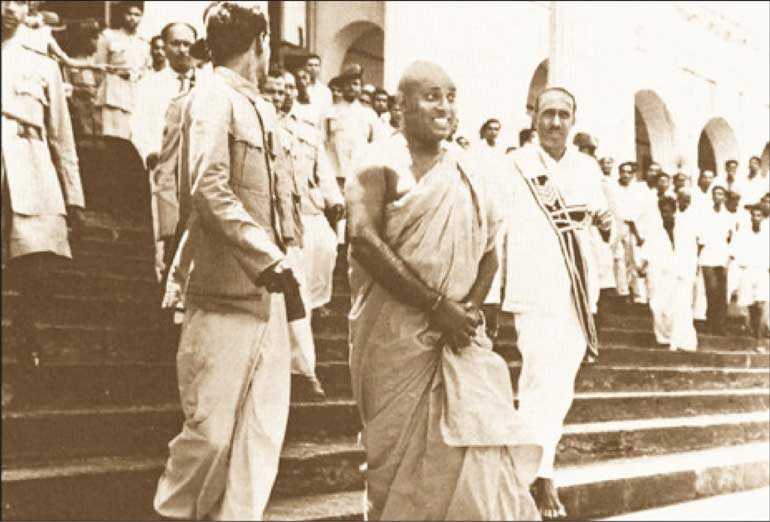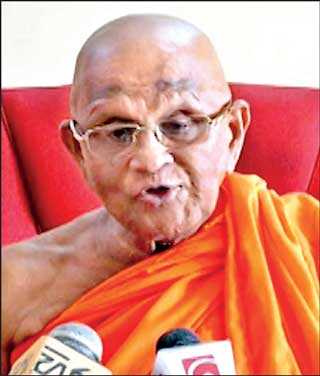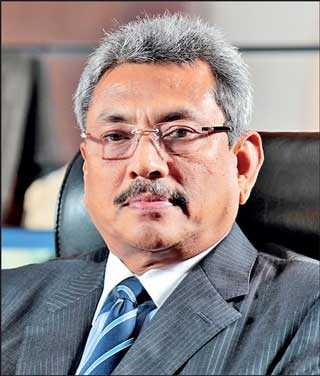Wednesday Jan 21, 2026
Wednesday Jan 21, 2026
Friday, 20 December 2019 00:25 - - {{hitsCtrl.values.hits}}

Venerable Muruththettuwe Ananda Thero, the Chief Incumbent of Abayaramaya, Narahenpita made a unique statement to the public. He said that the Government is in a dire situation in which it finds  difficult to meet its daily expenses and made an appeal to the Sinhala diaspora to donate as much dollars as possible to the Government.
difficult to meet its daily expenses and made an appeal to the Sinhala diaspora to donate as much dollars as possible to the Government.
At the same time, the Venerable Thero cited the example of Thailand where the Buddhist priests had offered to donate the wealth of their temples to the government in response to a request made by the King of Thailand when the country faced a similar situation.
The Venerable Thero added that it is appropriate for the bhikkus of Sri Lanka also to donate the wealth of the temples to the Government at this hour of difficulty and as a support to the leader chosen by the people to steer the leadership of the country.
Though the above statement had been made not by the President or the Prime Minister of the country, it is not difficult to understand that the State of Sri Lanka is in a dire state of bankruptcy.
This situation was highlighted by me in my last week’s article in a different way where I mentioned about the candidates who contested the Presidential Election as follows: “All the candidates who contested the Presidential Election sought a mandate from the public to rule the country which was not in a healthy state, but had reached a level of bankruptcy in almost every aspect.”
Further, in another article written in the week before that (8 December), I stated that in 2019 Gotabaya has inherited a country which is not in good shape, but a country rotten and degenerated. I think the readers who had been following my articles will remember that I had repeatedly stressed that Sri Lanka will soon end up in bankruptcy like Greece if it fails to introduce structural reforms. I made this observation, not today, but in 2010, soon after the internal civil war was won in 2009.
Mahinda Rajapaksa regime
 |
Venerable Muruththettuwe
|
 |
President Gotabaya Rajapaksa |
The violent uprisings of Sinhala and Tamil youths in Sri Lanka were triggered by the failure to build, prior or after independence, a modern nation that will not leave room for conflicts based on ethnicity, caste or creed. The ethnic, caste and religious differences impacted heavily on the rebellions occurred in the Sinhalese and Tamil societies.
From inception, I held the view that the structural reforms were essential to put right the massive distortions created in the social, political and economic system, apart from the immense destruction caused to the lives and property by violent clashes which lasted for nearly 30 years, and failure to do so would inevitably push the country into a state of anarchy. In 2011, I wrote and published a book titled ‘Sri Lankava Galavaganima’ (Rescuing Sri Lanka) to enlighten the society and the rulers on this situation.
I made this issue the main theme of the 25th anniversary of the Ravaya newspaper. I made an attempt to bring together all the Sinhala, Tamil and Muslim leaders into that occasion and stress them of the urgent need for going for structural reforms. But it failed. Thereafter, I tried to convince President Mahinda Rajapaksa of the need for structural reforms; but that too was not successful.
I was of the view that Mahinda’s policy of ignoring constitutional reforms would thrust the country back into a state of big crisis and even lead to his defeat at the Presidential Election 2015. And it did.
Yahapalana distortion
I was of the opinion that the implementation of the formula that advocated the employment of a common candidate to defeat President Mahinda Rajapaksa would cause a great deal of confusion in the political course of the country.
It was a few UNPers who were strongly against Ranil who had brought the concept of common candidate to the fore, using Venerable Maduluwawe Sobitha Thero as a protective shield. The hidden intent of their program had been to defeat Mahinda by using the strength of the UNP in a manner that Ranil would not get the power.
The UNP, which operated as the main Opposition, had the right to decide the candidate for the Presidential Election. I was of the view that bringing in an outsider to the fore as the common candidate would create a big mess if he came to power.
I spoke to Sobitha Thera about it. Sobitha Thera listened to what I was saying, attentively, but by that time the program to field a common candidate had gone too far to make a change in the decision. I spoke to the UNP Leader too, about it and advised him to express his consent to the United National Front and contest the Presidential Election; even if some confusion may arise initially, it might disappear when nominations are given and he will be able to win the election. He had the ability to understand the potential, but lacked the self-confidence to become the presidential candidate.
When Maithripala Sirisena agreed to be the common candidate, Ranil seemed to have presumed that he would be able to use the former as a puppet on account of his mediocre social background.  However, after winning the Presidential Election Maithripala Sirisena did not want to be a puppet of Ranil Wickremesinghe. They both lacked the discipline needed to work together with understanding and in collaboration. In the end, the two leaders of the Yahapalana Government turned out to be two comic figures in the face of the people.
However, after winning the Presidential Election Maithripala Sirisena did not want to be a puppet of Ranil Wickremesinghe. They both lacked the discipline needed to work together with understanding and in collaboration. In the end, the two leaders of the Yahapalana Government turned out to be two comic figures in the face of the people.
The stray journey
If the Yahapalana Government had opted to go for a Parliamentary Election, soon after the victory of the Presidential Election without a delay, the UNP would have been able to secure a significant majority in the Parliament. But despite this, the option adopted to implement a 100-day program with limited objectives, designed by a group of inexperienced political novices, in the Parliament where Mahinda Rajapaksa had the majority power; the Yahapalana Government not only messed up the program but also lost the opportunity and the capacity to strengthen its power in the Parliament.
The definition of corruption presented by Yahapalana theorists was also not realistic and correct. It was not Mahinda Rajapaksa who had introduced the practice of massive corruption to the country. In fact, mass-scale corruption was originated by the UNP in 1977. Since then, all successive governments had adopted a policy of plundering public property. Although the volume of corruption has steadily increased during the regime of Mahinda Rajapaksa, it was a situation that had persisted unhindered since 1977 and was not a thing that was originated during the regime of Mahinda Rajapaksa.
But the policy adopted and implemented by Yahapalana theorists, in defining the large-scale corruption as a phenomenon that originated only during the regime of Mahinda Rajapaksa, led to create a hostile attitude in the Opposition. In this backdrop, if the investigation into corruption has not been confined only to the Rajapaksa regime and applied even to cover the previous regimes, the recognition of the program would have been more justified and enjoyed a wide public support.
As I have pointed out at that time, spending public money to give historical value for the family properties cannot be considered a justifiable move. However, it is not reasonable to adopt a strict policy against Rajapaksas alone in this respect when all previous presidents-JR Jayawardene, Premadasa and Chandrika had been guilty of the same practice.
The initiation of action, irresponsibly and ineffectively, against Rajapaksas alone, without resorting to a common policy applicable equally for all those who had done wrong can be said to have created a necessary condition for the Rajapaksa camp to restore its survival and regain power.
Gotabaya’s victory
Not only did the Yahapalana Government abstain from embarking on structural reforms to resolve the national crisis, but it also refrained from curbing the situations that led to the worsening of ethnic and religious tensions. Under the circumstances, ethnic and religious divisions deteriorated to the level of rotting and pestering. This situation led to weaken and deteriorate the people’s base of the Government and strengthen that of the Rajapaksa camp.
Despite being conscious of the huge financial crisis the country is facing, the Yahapalana Government did many nonsensical things merely to strengthen its electoral base. Increase of the monthly salary of public servants by Rs. 10,000 before the Parliamentary Election 2015 is one such example.
The country’s economy did not have a true capacity to increase the salaries; the additional expenditure incurred by the Government for the salary increase amounted to Rs. 160,000 million. The additional expenditure incurred in this respect, in the year 2016 was Rs. 135,489 million. It was 140,359 million in 2017.
Despite the country drifting into a state of bankruptcy, the Government continued to borrow more and more foreign debt and spent lavishly on things that were of no meaning and use. If the estimate presented by Prof. GL on the cost of compilation of the proposed new Constitution which was not completed is correct, the amount incurred or wasted in this unsuccessful project had been Rs. 13,600 million. It is amazing to note the way the public money had been squandered in a country which is drifting towards virtual bankruptcy.
This had not been a characteristic peculiar only to the Yahapalana Government. That is how almost every successive government had acted upon since 1977.There is nothing wrong in borrowing money provided there is a discipline in using them effectively for the development of the country. But, none of the development ventures initiated with foreign loans in Sri Lanka had been able to repay the loans with the income generated from enterprise itself. For instance, the income generated from highways is only adequate to cover the cost of maintaining them.
Although the Yahapalana Government did not work on policies based on racial and religious divisions, it however failed to manage properly and effectively, the racial and religious passions and emotions that erupted occasionally; and also its failure to manage properly and systematically the incidents of racism and religious fanaticism that had been well planned, has once again made Sri Lanka a country prone to racism and religious extremism.
Surprisingly, in this backdrop, it is not the minority ethnic groups or religious communities, but the Sinhalese Buddhists, the majority community that had harboured a fear of survival. This strange mentality that prevails among the majority community can be regarded as a condition created artificially on a perceived or non-existent threat rather than a natural outcome of a real threat.
However, the terrorist attacks launched on Easter Sunday contributed immensely to increase the intensity of this state of mind shared by the majority community and crystallise it. The overwhelming victory of Gotabaya Rajapaksa in the Presidential Election can be considered the culmination of this bizarre socio-political environment.
Challenges ahead of Gotabaya
With the victory of Gotabaya, all Opposition parties, including the UNP, have fallen into a state of shock and passivity. More than a month has passed, yet, they have not been able to recover from the shock and regain consciousness.
It is unlikely that Gotabaya’s advance will be challenged at the initial stages by the Opposition parties. But he might be compelled to face challenges not from outside but from within, from his own support base. He will be compelled to appease the monks who acted as the driving force of his victory. He will be able to implement things which may meet with the approval of the Sangha. Concurrently, he should please the Prime Minister, his brother. He will also have to be kept in a comfortable position.
As happened during the Yahapalana regime, once again, the country has two leaders and it is not clear who among them is the foremost. In contrast to the former President Sirisena and former Prime Minister Ranil Wickremesinghe, these two leaders, Gotabaya and Mahinda, are two brothers in the same family, but there can be contradictions and idiosyncrasies peculiar to them.
One of the biggest challenges the new President faces is the present problem of the country, the status of which is not generally good but in an utter degeneration. It is also highly divisive in ethnic and religious terms. It is a country that is replete with inefficiency and rampant corruption. It is a country where production and trade have collapsed to the bottom. It is a country gripped in debt crisis to a maximum; virtually the country has reached the verge of bankruptcy. It has to pay $ 4,000 million annually, which is equal to 115% of the annual income of the Government, by way of instalments and interest on foreign loans.
Learning from Bandaranaike
Rescuing the country out of this situation cannot be simple or easy. The obstacles that a leader who has come to power with the support of one race and one religion has to face are more complex and difficult than those to be faced by a pluralist leader or a leader elected by the vote of all races and religions.
The biggest problem the country is facing is not as simple as the question of the perceived threat to the very existence of Sinhala race or Buddhism. It is a much more complex question involving a danger to the country’s socio-economic and political existence.
There is an important lesson that the new President should learn from the unfortunate experience of Prime Minister Bandaranaike who came to power in 1956 in a similar manner with the overwhelming support of the Sangha.
Bandaranaike was not a racist or religious leader though he adopted a policy that placed more weight on Sinhala Buddhist emotions to achieve his political ambitions and gain political power in ’56. He might have believed that after coming to power, he would be able to act reasonably and without becoming a prisoner of extremist forces. He was prepared to grant the right to Tamils in the north and the east to work in Tamil while making Sinhala the national language. He had a draft bill prepared for this in his possession.
But he prevented himself in submitting it to his parliamentary group as it demanded a Sinhala Only policy, with no room for the Tamil language; instead Bandaranaike appointed a committee to prepare a suitable draft, without presenting to them the language bill that he had in his possession. The Committee accepted the Model Language Act, which L.H. Mettananda had prepared without granting concessions to the Tamil language and adopted it as the Language Act. Subsequently, Bandaranaike reached an agreement with Chelvanayagam when the Tamils protested strongly against it.
When the Buddhist monks agitated against the agreement, Bandaranaike was compelled to tear it. Simultaneously, for the first time, a Sinhala-Tamil riot broke out in the country. This ironical political drama eventually ended with Prime Minister Bandaranaike being assassinated by a monk. It was the first political assassination in Sri Lanka since independence. Mapitigama Buddha Rakkitha Thero, the Chief Incumbent of Kelaniya Raja Maha Viharaya and the founder of the United Bhikkhu Peramuna, was the mastermind behind the assassination of Prime Minister Bandaranaike.
Though it is easy to come to power on the support of racist and religious forces, it is however difficult to govern a country under their influence. If the country is to recover from its tragic situation, first of all, it is necessary to find a solution to the national crisis Sri Lanka is presently facing. Although there is a greater likelihood of solving this problem by a leader who is well-respected by the Sinhala Buddhist community than with one who lacks it, it would only be possible if the leader is adequately equipped with the wisdom and courage required to develop a broad and reasonable outlook which is not confined only to one race or one religion and capable of managing properly, the Sinhala Buddhist emotions.
One of the best ways to overcome a crisis of this nature is to direct the country to win a people’s constitution to achieve an overall structural change in the entire system of governance. It sets out a common program to save the country, not just the government, but all political parties, and all people, regardless of race, religion or caste.
Since it is a program that actively engages not only the political parties but also the public, to solve the country’s major problems, it is essential that the support of the international community is received for it. It provides the necessary background to genuinely discuss and solve all the fundamental issues that need to be addressed and resolved.